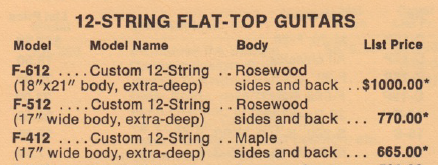Perfectly reasonable question and I understand the reasoning behind it. "How does one define 'original?' was a question I asked myself in working through this. I came to two alternatives, either it came as seen direct from the factory and so "original" in the normal sense or it was perhaps delivered to a 3rd party by the factory who was responsible for the non-factory features, then delivered it to the original purchaser, making it "original" to him as that is the way it was when he first laid eyes on the guitar. The description of being all original was what was said to the son of the man who first purchased the guitar. The son then repeated that description to the guy he sold to i.e. the guy I bought it from and who also described it as all original. Without any documentation, either answer will forever be conjecture.
BTW, it is my understanding that many Guild guitars, especially 12 strings, were not held in stock but had to be ordered from the factory. They were not considered "special order". That was reserved for guitars that were made to the customers specific instructions. There were two years that the 612, 512, and 412 were offered as "Custom" variation with upgraded components. See the catalog images elsewhere in this thread.
All that being said, after considering all the opinions and suggested possibilities and especially when I talked to the guitar tech at South Austin Music and who spent some time going through the details, I believe the weight of evidence is heavily in favor of the guitar having been delivered to the man who first purchased it as we see it now. He did not get a standard issue Custom", as described by the catalog and then send it out to be changed. Without going over again what evidence was presented, the areas in question I can say with a high degree of certainty were original to the guitar. Was the work done by an employee of Guild? I can't say with 100% certainty. Was it NOT done by an employee of Guild? I can't say with 100% certainty. Neither could South Austin Music. BTW, they are an independent shop who've been in the same location for 39 years and deal primarily in vintage gear, though they do have some new stuff as well. They even had a new F-512.
You may have seen a 1970 F-512 for sale that was described as a prototype and apparently was described as such by Carlo Greco. It is very similar to this guitar in having the fret board and bridge inlays like the F-612 and a couple of other details. Now the son of original owner said his dad had a collection of high end acoustics from the Martin, Gibson, and Guild spanning the style range of each company. Guy must have had a shed load of money. I get the impression that he wanted each to be unique. Now if he had ordered a few from Guild and built a relationship it would be very possible that Guild built this guitar for him starting with a guitar that had not been completed. It has been suggested that Guild may well have had a few unfinished guitars of very low volume models like the F-512 Custom that would be finished only when ordered. They could have said, "Hey look, you want something unique. Could we try out a couple of ideas?" Might have been done with a phone call. Since the guitar was not ordered with specific specifications from the customer it might not have been considered a "Special" and considered a prototype. Prototypes are not normally marked as such. The one from 1970 was not. The guy gets it, likes it, and keeps it but there's no detailed paperwork. Thus a mystery is created. Or maybe they had built another prototype and when the guy called offered it to him. Either is conjecture, of course, but it would explain why the pick guard, finish, etc do very much appear to have been applied to a "raw" guitar. I can't imagine they would have sent it to some unknown 3rd party that way. Still, no proof positive.
All of that brings me back to believing the best description is "A 1972 F-512 Custom with customization believed to be original to the guitar, possibly done by the factory." It's academic really. End of the day I have a really great 12 string that's
very unique. Full disclosure, I paid $3,000 for it. When I think of the folks who commented that "No educated person on this board would ever buy that guitar," I just smile to myself and think, "Glad they didn't, Skippy."



